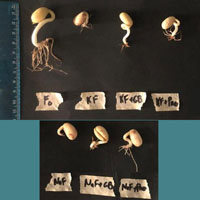First insight of exogenous addition of proline and glycinebetaine to mitigate fluorine toxicity effects on common bean seedlings

Accepted: 10 December 2020
PDF: 561
All claims expressed in this article are solely those of the authors and do not necessarily represent those of their affiliated organizations, or those of the publisher, the editors and the reviewers. Any product that may be evaluated in this article or claim that may be made by its manufacturer is not guaranteed or endorsed by the publisher.
To counteract fluoride (F) stress-induced adverse effects on plants, one approach is the application of exogenous potential osmoprotectants such as proline (Pro) and glycinebetaine (GB). This experiment was carried out to evaluate the effects of exogenous application of Pro and GB on germination and growth of common bean seeds after potassium fluoride (KF) and sodium fluoride (NaF) exposure. The study was replicated under two different temperatures: the normal temperature required for seeds growth (20°C) and a higher (25°C) favourable for bean cultivation in Africa, the region most polluted with F. The results indicated that the beneficial effects of external supply of Pro and GB varied depending on temperature and the source of salt stress. NaF showed a more toxic effect than KF on growth of Phaseolus vulgaris seeds. Overall, Pro was more effective than GB to alleviate the undesirable effect of salt stress on morphological attributes under NaF stress (improving by 50% and 39% the length and the number of lateral roots), and especially at higher temperature the recovery role of Pro and GB was more relevant reaching the same value found under control conditions for the length of hypocotyl (3.28 cm).
Highlights
- Exogenous glycinebetaine and proline were able to counteract F inhibitory effects on Phaseolus vulgaris seedlings growth.
- Sodium fluoride (NaF) showed more toxic effect than potassium fluoride (KF) on Phaseolus vulgaris seedlings growth.
- Proline was more effective than glycinebetaine in alleviating F toxicity effects on seedlings growth.
How to Cite

This work is licensed under a Creative Commons Attribution-NonCommercial 4.0 International License.
PAGEPress has chosen to apply the Creative Commons Attribution NonCommercial 4.0 International License (CC BY-NC 4.0) to all manuscripts to be published.

 https://doi.org/10.4081/ija.2020.1754
https://doi.org/10.4081/ija.2020.1754



